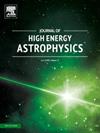A white dwarf binary candidate discovered by LAMOST using dynamical method
IF 10.2
4区 物理与天体物理
Q1 ASTRONOMY & ASTROPHYSICS
引用次数: 0
Abstract
We present the discovery of a binary system containing a white dwarf candidate using data from the LAMOST. Our analysis of the radial velocity data allowed us to determine an orbital period of approximately 0.953 days and a mass function of 0.129 . Through spectral energy distribution (SED) fitting, we obtained the stellar parameters of the visible star. By combining these results with the mass function, we established a relationship between the mass of the invisible star and the system's inclination angle, along with the Roche lobe radius. We find that the mass of the invisible star is below the Chandrasekhar limit when the inclination angle exceeds . Given that systems with large variations in radial velocity typically have high inclination angles, we classify the invisible star as a white dwarf candidate. The Roche lobe radius exceeds the physical radius of the visible star, indicating that no mass transfer occurs, which results in a weak ellipsoidal modulation effect. Additionally, we obtained light curves from the TESS, ASAS-SN, and CRTS surveys. The light curves also exhibit a periodicity of approximately 0.95 days, with ellipsoidal modulation only in the 2019 TESS observations. Coupled with the strong emission line observed in the LAMOST MRS spectrum, we infer that the surface of the visible star contains significant hot spots. This obscures the system's inherently weak ellipsoidal modulation, resulting in a manifestation of rotational variables. Furthermore, an analysis of the dynamical characteristics of this system indicates that it has a high inclination angle (>60 degrees) and its orbital properties are consistent with those of typical thin disk stars, supporting the hypothesis that the invisible object is a white dwarf.
LAMOST用动力学方法发现的一颗白矮星候选双星
我们使用LAMOST的数据发现了一个包含白矮星候选者的双星系统。我们对径向速度数据的分析使我们确定其轨道周期约为0.953天,质量函数为0.129 M⊙。通过光谱能量分布(SED)拟合,得到了可见恒星的恒星参数。通过将这些结果与质量函数相结合,我们建立了不可见恒星的质量与系统倾角以及罗氏叶半径之间的关系。我们发现,当倾角超过35°时,看不见的恒星的质量低于钱德拉塞卡极限。考虑到视向速度变化较大的系统通常具有较高的倾角,我们将这颗看不见的恒星归类为白矮星候选者。罗氏瓣半径超过了可见恒星的物理半径,表明没有发生传质,这导致了弱的椭球调制效应。此外,我们还获得了TESS、ASAS-SN和CRTS巡天的光曲线。光曲线也表现出大约0.95天的周期性,只有在2019年的TESS观测中才出现椭球调制。结合LAMOST MRS光谱中观测到的强Hα发射线,我们推断可见恒星表面存在明显的热点。这掩盖了系统固有的弱椭球调制,导致旋转变量的表现。此外,对该系统的动力学特性分析表明,该系统具有较大的倾角(>;60度),其轨道性质与典型的薄盘星一致,支持了该不可见物体是白矮星的假设。
本文章由计算机程序翻译,如有差异,请以英文原文为准。
求助全文
约1分钟内获得全文
求助全文
来源期刊

Journal of High Energy Astrophysics
Earth and Planetary Sciences-Space and Planetary Science
CiteScore
9.70
自引率
5.30%
发文量
38
审稿时长
65 days
期刊介绍:
The journal welcomes manuscripts on theoretical models, simulations, and observations of highly energetic astrophysical objects both in our Galaxy and beyond. Among those, black holes at all scales, neutron stars, pulsars and their nebula, binaries, novae and supernovae, their remnants, active galaxies, and clusters are just a few examples. The journal will consider research across the whole electromagnetic spectrum, as well as research using various messengers, such as gravitational waves or neutrinos. Effects of high-energy phenomena on cosmology and star-formation, results from dedicated surveys expanding the knowledge of extreme environments, and astrophysical implications of dark matter are also welcomed topics.
 求助内容:
求助内容: 应助结果提醒方式:
应助结果提醒方式:


